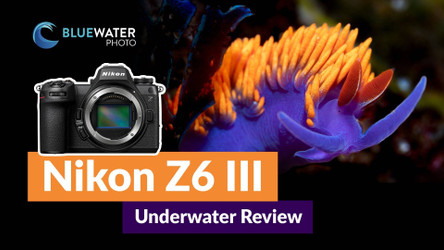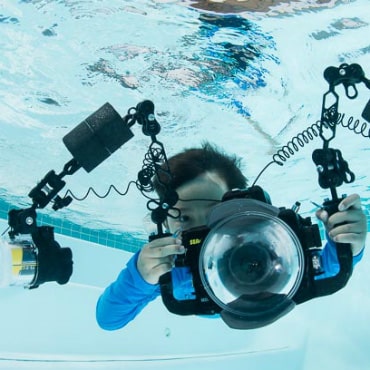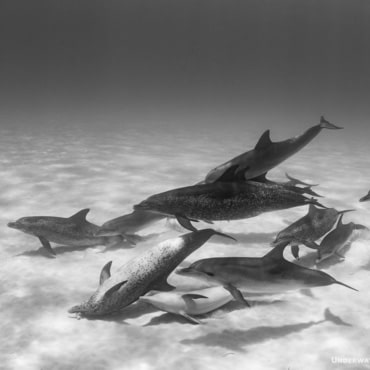Nikon Z6III Underwater Review
Posted by Nirupam Nigam on August 24th, 2024

Lightning Fast Autofocus on a 24.5 Megapixel "Prosumer" Full Frame Camera
Nikon's latest offering, the Nikon Z6III full frame mirrorless camera, marks a significant leap forward, positioning the brand at the forefront of camera innovation. This model presents a compelling option for Nikon DSLR enthusiasts contemplating the switch to mirrorless technology as well as older Z6 users that may have been disappointed in the autofocus of previous models. Moreover, the Z6III is a truly video oriented camera with internal RAW recording and 4K frame rates up to 120fps. The Z6III may well be the ideal mid-range full-frame mirrorless camera for hybrid photo and video shooters. The camera boasts Nikon's cutting-edge autofocus system, first seen in the Z9 and Z8 models, along with enhanced sensor readout speeds, reduced rolling shutter effect, impressive 8-stop in-body stabilization, and 6K RAW video capabilities.
At the heart of these advancements lies what Nikon calls "the world's first partially stacked CMOS sensor." This innovative design aims to boost processing speeds, resulting in a 3.5x faster readout compared to its predecessor, the Z6 II. However, early reports suggest a trade-off: a potential loss of about one stop of dynamic range at lower ISOs when using the mechanical shutter. This could be a concern for underwater photographers, especially those capturing wide-angle shots with challenging lighting conditions like "sunballs." Fortunately, we've had the opportunity to put the Nikon Z6III to the test in Southern California's Channel Islands. We made sure to photograph sunballs through the beautiful ethereal glow of the kelp forests as well as the smallest critters of the kelp forest like spanish shawl nudibranchs and pyrosomes. While every photographer may have a differing opinion on the Z6III's performance, we've been thoroughly impressed with the camera as you can see in the images below.

Nikon Z6III Top Specifications
- 24.5 megapixel partially-stacked full-frame CMOS sensor with AA (low pass) filter
- 5 axis in-body image stabilization with up to 8 stops of correction
- Expeed 7 processor
- Z lens mount (F lenses used with FTZ adapter)
- 14fps burst shooting with mechanical shutter and 20 fps burst shooting with electronic shutter
- 6K/30, 5.4K/60 & 4K/60p (oversampled) video
- 4K/120p video with 1.5x crop
- N-RAW and ProRes RAW internal recording
- Full size HDMI 2.1 connector (compatible with Marelux Ninja V housing and cables)
- 1/200 flash sync speed
- Improved autofocus and subject tracking
- Lowlight AF sensitivity down to -10 EV
- 10.46 stops of dynamic range at ISO 100
- CFexpress type B and UHS-II card sos
- Dimensions: 5.5 in x 4 in x 3 in
- Weight 670g
Top Features of the Nikon Z6 III
- Innovative Sensor: Partially stacked CMOS design for faster processing
- Enhanced Autofocus: Utilizing Nikon's latest AF system
- Improved Speed: 3.5x faster sensor readout than the Z6 II
- Stabilization: 8 stops of in-body image stabilization
- Video Capabilities: 6K Internal RAW video recording
- Reduced Rolling Shutter: Better performance for moving subjects
- Potential Trade-off: Possible slight reduction in dynamic range at low ISOs

What This Means for Underwater Photographers
- Faster Autofocus: Game-changing for capturing quick-moving marine life
- Improved Stabilization: Helpful in challenging underwater conditions
- Enhanced Video: 6K RAW offers more flexibility in post-production
- Dynamic Range Considerations: May require adjusted shooting techniques for high-contrast scenes

A Deeper Dive Into the Nikon Z6III
A New Partially Stacked Sensor
The Nikon Z6III introduces a game-changing 24.5 megapixel sensor that, while similar in resolution to its predecessors, represents a significant leap forward in technology. As Nikon's first "partially stacked" sensor, it boasts a readout speed 3.5 times faster than the Z6 II. This advancement nearly eliminates rolling shutter effects, a crucial benefit for action and sports photographers who rely on the camera's electronic shutter. Underwater photographers capturing swift subjects like sailfish, sharks, and dolphins without strobes may find this feature particularly advantageous over the Z6 II. The rapid readout speeds promise crisper, less distorted images of quick-moving subjects when using the electronic shutter. It also enables the camera to fire 20 frames per second RAW images with the electronic shutter. While we kept most of our burst shooting to 3-5 frames per second, it was nice to know we could switch to 20fps any time we wanted without strobes.
It's worth noting, however, that the new sensor comes with a trade-off: slightly reduced dynamic range at lower ISOs, measuring 10.46 stops at ISO 100. While this difference may go unnoticed in many shooting scenarios, underwater photographers often encounter lighting situations that demand maximum dynamic range. For instance, wide-angle shots featuring a "sunball" require preserving details in both the bright highlights (the sun) and the shadows (often illuminated by strobes). To test just how far we could push the dynamic range of the Z6III, I made sure to photograph a series of sunball photos in the kelp forests of Anacapa. I did notice that it was a tad bit more difficult to get details in the highlights than with previous models of the Z6III. But most photographers would not take issue with the results, or even notice the difference when compared with the Z6II.

Enhanced Autofocus System
One of the primary hurdles for Nikon DSLR users considering a switch to mirrorless has been autofocus performance. While the Z7/Z6 and Z7 II/Z6 II offered good autofocus capabilities, they often merely matched DSLR performance rather than surpassing it, unlike some Sony and Canon models. The Nikon Z8 and Z9 introduced a vastly improved autofocus subject tracking system, boasting quicker acquisition and enhanced accuracy. The Z6III promises to incorporate this same advanced autofocus system, positioning it competitively against popular "prosumer" mirrorless models like the Sony a7 IV and Canon R6 Mark II in the $2500 price range.
During our underwater tests, the difference in autofocus speed was clearly apparent - especially when using the notoriously slow Nikon Z 105mm macro lens. While the Z version of this lens is much sharper than the F mount version of the lens, slower autofocus disuaded me from upgrading to the Z lens until Nikon came out with it's new autofocus system. Now, with the Nikon Z6III, I hit almost every macro shot including this beautiful capture of a pyrosome (pelagic tunicate colony) floating through the water column. The autofocus speed and acquisition when using "3D" tracking is almost comparable to the Canon R5 Mark II and Sony a7r V. It's still just a hair slower and less accurate, but autofocus is no longer a reason that I might consider moving to a different brand.

Improved In-Body Image Stabilization
The Nikon Z6III features an impressive 5-axis IBIS (in-body image stabilization) system, offering up to 8 stops of correction. This technology employs a gyroscope-mounted sensor that compensates for movement and camera shake during handheld shooting. As a result, photographers can use shutter speeds up to 8 stops slower without introducing motion blur from camera shake. While many underwater photographers prefer faster shutter speeds to freeze their subjects, this feature will prove invaluable in low-light conditions.
For instance, when diving in the cold, often murky waters of the Pacific Coast, slower shutter speeds are sometimes necessary to capture the water's color in wide-angle backgrounds. Without adequate stabilization, these shots can result in dark, almost black backgrounds on overcast days. It's possible to see this concept in the image below. The kelp forests at Anacapa were so thick that there is a black background behind the garibaldi in the photo. A slow shutter of 1/30th of a second was necessary to capture the green glow of light through the kelp. Normall this slow shutter speed would cause motion blur from camera shake, but this was not the case in the photo.
The 8-stop IBIS will be a game-changer for underwater videographers shooting handheld footage. We're excited to see how this translates to smoother underwater video, especially when combined with the camera's ability to capture oversampled 4K/60p footage in N-RAW.

Impressive Batterylife
After two days of diving and shooting non-stop with the Nikon Z6III, we thought it would be worth mentioning that the batterylife on the camera is impressive. Although it's rated for only 390 shots with the LCD, I was able to capture 300 photos in three dives and still had 58% battery left. Personally I think the Z6III should be able to last 6-7 dives on one battery. This means you can just charge the camera after a full day of shooting - even if you plan on doing 5 dives. I used the new Ikelite charging and data transfer bulkhead so I didn't need to take the camera out of the housing between days of diving.

Build Quality and Ergonomics
The Nikon Z6III is, in my opinion, one of the best handling cameras on the market. The body is made from a sturdy magnesium alloy. It's significantly smaller than the Nikon Z8 but slightly larger than the original Z6 and Z6II (by about 50 grams). Anyone familiar with Nikon mirrorless cameras will be familiar with the layout on the Z6III. Not much has changed. The d-pad provides easy control for autofocus, the EVF button allows for quick switching between the EVF and LCD, and finally the video to photo mode switch is still one of the best ideas in camera engineering. The "i" menu allows for easy access to your most used settings. Overall, the Z6III is an easy to use camera packed with features. The only thing we wish we saw on the body was more customizeable buttons. That said we hardly use the existing customizeable buttons because of the wide range of options in the "i" menu. Be sure to check out our full Nikon Z6III underwater settings guide for a full overview of the top settings we used in this review.
Industry-Leading Video Capabilities
Nikon's recent acquisition of RED signals a clear commitment to video innovation in the coming years. The Z6III builds upon the Z6 II's video features, now offering 6K/30p video and 4K/60p oversampled video with N-Log, N-RAW, and ProRes RAW recording options. 4K/120p is also possible in the DX (1.5x crop) mode. While most video shooters will likely opt for N-Log to maximize dynamic range, the RAW recording features provide ultimate flexibility in post-production for high-end productions.
The ability to shoot 4K/60p video without cropping positions the Z6III as a frontrunner in the mid-range full-frame video camera market. It may well become our preferred choice over competitors like the Sony a7 IV and Canon R6 Mark II.
Overall, we were extremely impressed with the underwater footage we captured with the Z6III. When we initially filmed with the Nikon Z8 in July of 2023, we noticed it was impossible to do a manual white balance below 50 feet deep. So when the Nikon team came to visit Bluewater, we let them know that we would love to see an improvement in the manual white balance capability. With the Z6III we are happy to report this improvement was made and we were able to capture manual white balance well below 50 feet. Overall the footage we captured had beautiful color and detail. Stay tuned for the footage to be released soon on our youtube channel!
Nikon Z6III Underwater Housings
Given the anticipated popularity of the Z6III, we expect most leading underwater housing manufacturers to develop compatible options. Currently, the Nauticam Nikon Z6III underwater housing is available in anodized aluminum, while the Ikelite Nikon Z6III underwater housing offers a polycarbonate option. We also anticipate excellent housing solutions from Marelux, Isotta, and Aquatica to be released in the near future.
During our underwater review, we used the Ikelite Z6III housing. This affordable, yet durable, polycarbonate option allows you full control of the camera. Every button and dial has a control on the housing except for the joystick control, which is unnecessary with Nikon cameras underwater. The Ikelite housing has updated dial controls which are made from a harder polycarbonate material and designed to be easy to turn - even with large gloves in cold water. We decided to install the new Ikelite data transfer and charging bulkhead into the housing so that we didn't need to take the camera out of the housing between dives. But perhaps the most enticing feature of this housing is the TTL converter compatible with Ikelite strobes. This converter allows you to take photos with your strobe without needing to adjust the strobe power! It's one of the most accurate TTL systems on the market.


Top Nikon Z6III Underwater Lens Options
Nikon Macro Lens Options
Nikon F 60mm f/2.8 macro w/ FTZ adapter - This lens stands out among Nikon's offerings. When paired with a full-frame camera like the Nikon Z6 III, it excels with the Kraken KRL-09s wide-angle conversion lens, providing a 154-degree field of view. It's our top pick for blackwater photography and can focus closer than 105mm macro lenses.
Nikon F 105mm f/2.8 macro w/FTZ adapter - If you already own this lens, it remains a top choice for the Nikon Z6 III. Its relatively long working distance is advantageous for approaching shy subjects. Interestingly, it focuses faster than its Z mount counterpart, though it's not as sharp.
Nikon Z 105mm f/2.8 macro - This lens is one of the sharpest macro lenses we've ever used. While it may be slightly slower than other options, including the F mount version, the Z6 III's improved autofocus makes it our preferred choice for macro photography.
Nikon Z 50mm f/2.8 macro - We don't recommend this lens for underwater photography. Despite being more affordable, its moving focusing barrel results in slow image quality and it's challenging to use with diopters.
Kraken and Weefine +13 macro lens - These are excellent choices to pair with the Nikon Z 105mm macro for supermacro photography. We encourage you to explore our comprehensive guide to wet macro lenses.

Nikon Wide Angle Lens Options
Nikon F 8-15mm fisheye lens w/ FTZ adapter - This classic lens is our favorite for underwater photography. At 8mm, it offers a circular field of view, while at 15mm, it provides a wide fisheye field of view of about 170 degrees. It's ideal for capturing close-up reef subjects with maximum color and detail.
Nikon Z 14-30mm rectilinear wide lens - This lens is fantastic for photographing subjects at a slightly greater distance, such as sharks and dolphins. It boasts relatively sharp corners for a rectilinear wide lens and transforms into a circular fisheye when used with the Nauticam FCP-1.
Nikon F 16-35mm f/4 w/FTZ adapter - If you already own this lens, it remains a great option for subjects similar to those suited for the Z 14-30mm. However, it's not as sharp as the Z version, so you might consider upgrading.

Conclusions
The Nikon Z6III represents a significant step forward in mirrorless camera technology - particularly for video shooters. In many ways, the Nikon Z6III is one of the world's leading cameras for underwater video and represents the best value for money option on the market. Its improved autofocus and processing speeds are particularly beneficial for underwater photography, where split-second timing is often crucial. The enhanced stabilization is a boon for both still and video work in unpredictable aquatic environments.
However, the potential reduction in dynamic range at lower ISOs is a point of interest for underwater shooters. But as you can see in our above underwater photos, for most shooters there is not a noticeable difference from the Z6II. That said, it might necessitate some adjustments in shooting techniques, especially for wide-angle scenes with bright surface light and darker depths. Overall, the Nikon Z6III is this year's top "prosumer" grade full-frame mirrorless camera. It topples the strong historical lead of the Canon R6 Mark II and Sony a7 IV. It's safe to say the Nikon Z6III represents the best camera for underwater photography in the $2500 price category.





